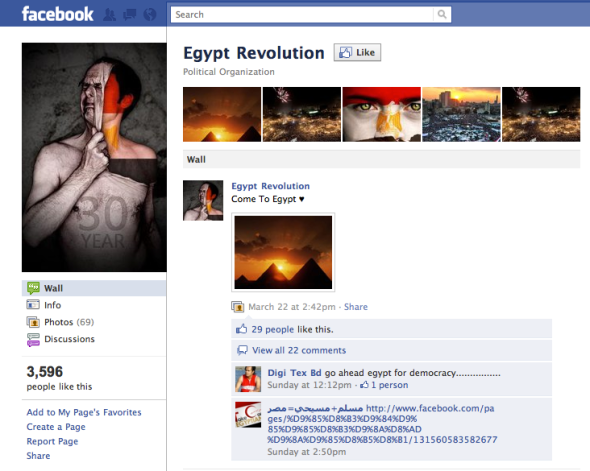Inside Cairo
Al Jazeera, the 24 hour news channel based on the outskirts of Doha, shows more graphic imagery than the BBC, ITN or Sky. It was the channel of choice for Bin Laden’s message after 9/11, and is now the channel of choice for breaking news now that the spotlight is on the Middle East revolutions – breaking news from clips such as the YouTube offering that seemed to confirm that Gaddafi security forces were attacking civilians. The scenes on Al Jazeera are more grizzly. They are not afraid of controversy. You will often see corpses and blood. On New York’s Daily Beast, the health warning of “graphic imagery” will accompany most clips aggregated from Al Jazeera. According to a recent article in The Sunday Times, there’s greater use of new media such as their Twitter feed and mobile phone footage downloaded from Facebook.
These videos add to the sense of immediacy and constant news. There’s always this question – how verifiable is this footage – is there an agenda behind posting graphic imagery. Can this immediacy be manipulated either by the rebels, or the regime?
By strange inversion, in the autocratic states themselves, TV is the untrusted medium. In Egypt, more trust is invested by the public in footage uploaded onto social networks which in turn makes the news on Al Jazeera, a channel which has been banned in Libya, and was also banned in Egypt after the uprisings.
“The way the news is presented is more sensationalist,” says Alex Hands, artistic director of Land in Focus, living in Cairo at the time of the revolutions. “The regime announced curfews during the revolution, but they were completely ignored. There was only rumour of when the curfew was. It was on TV but people didn’t believe State TV at the time and there wasn’t the internet to confirm these things.”
It may be a strange inversion, but when the broadcast medium is monopolised by the untrusted state, perhaps it is no wonder that the trust lies with footage edited by the people.
Words – HL
Inside Syria: Warning – graphic footage
Another revolution. Though Syria was expected to be the least likely to revolt, there has been footage that apparently shows Syrian security forces firing on mourners at a funeral yesterday.
Here’s footage that shows the injured protesters after the storming of the mosque.
According to Al Jazeera the southern city of Daraa has been cut off since Sunday. The authorities are letting people leave but not enter. As with Libya, it has been difficult for international journalists to cover the protests in Daraa, and phone service was disrupted on Friday.
Again, for the international media, we are increasingly reliant on footage that is difficult to verify. But when these clips are the only source we have to tell a story, we need to treat them seriously.
Words – HL
Inside Japan: More Footage
Building up a picture on the ground of the effects of the biggest earthquake in Japan is still difficult. The best footage is through official news outlets and views from above that have shown the fast-moving water and the fires at the nuclear plant at Fukushima, but here’s a video that captures the stealth of the water on CCTV at Sendai Airport:
This video shows the original effect of the earthquake in a grocery store:
Words – HL
Inside Libya
Dramatic amateur footage emerging from Libya is being used to tell the story from inside the country. With foreign journalists banned from the country, most are operating from the Tunisia/Libya border. Internet connections have been severed since 17th February so footage has been difficult to verify. But what’s been clear is that mainstream news outlets have had to depend on citizen journalism to build this horrifying picture from within.
We’ll be keeping an eye on the emerging footage and bring you the latest up-to-date news.
Security forces apparently firing at crowds at Benghazi via ITN, Feb 19th
Street battle in Benghazi, 24th Feb
Protests 18th Feb via Reuters
Words: HL


